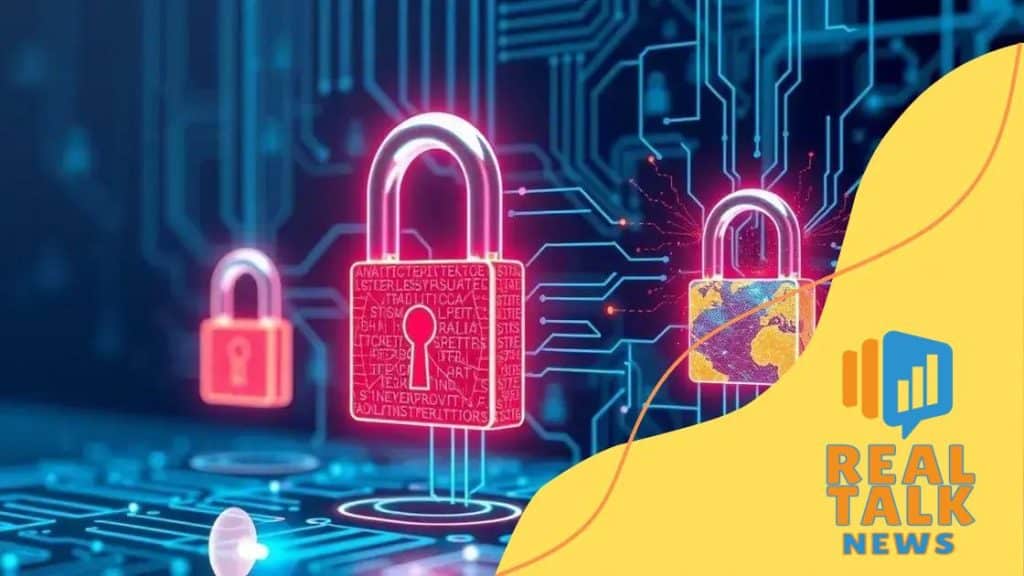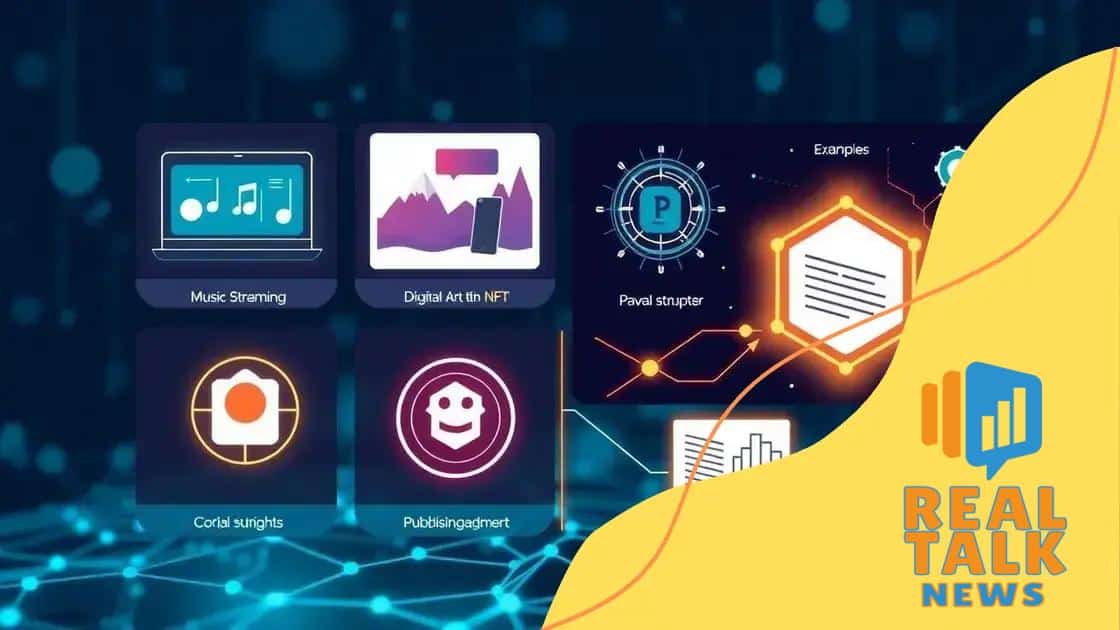How blockchain is reshaping intellectual property protection

Blockchain is reshaping intellectual property protection by providing secure, transparent, and tamper-proof records of ownership, enabling creators to manage their rights more effectively and efficiently.
How blockchain is reshaping intellectual property protection is a game-changer for creators and innovators. Imagine a world where your creative works are secure and easily verifiable. Curious to see how this technology can benefit you? Let’s dive in!
Understanding blockchain technology
Understanding blockchain technology is essential to grasp how it impacts various fields, especially intellectual property. Blockchain offers a secure way to record transactions that are transparent and immutable.
What is Blockchain?
At its core, blockchain is a decentralized digital ledger. This means that data is stored across multiple computers, ensuring security and reducing the risk of tampering. Each block in the chain holds a group of transactions, and once added, it can’t be modified without altering the entire chain. This feature makes blockchain incredibly secure.
Key Features of Blockchain
- Decentralization: No single entity controls the entire network.
- Transparency: All transactions are visible to authorized users.
- Security: Cryptographic techniques secure the data.
- Immutability: Once recorded, transactions cannot be changed.
These features make blockchain a revolutionary technology not just for cryptocurrencies but also for protecting intellectual property. Imagine creators having a reliable way to prove ownership of their work. With blockchain, every time a piece of content is created or modified, a new block can be added to the chain, capturing its history.
Moreover, the use of smart contracts in blockchain allows for automated and enforceable agreements. This means agreements regarding the use and distribution of intellectual property can be executed without the need for intermediaries. By reducing the reliance on third parties, blockchain technology streamlines processes and enhances trust among stakeholders.
As we continue to explore the implications of blockchain technology, it becomes clear that its role in securing and managing intellectual property is vital. It not only simplifies verification processes but also provides a layer of security that traditional methods lack.
The role of blockchain in IP protection
The role of blockchain in IP protection is becoming increasingly significant as more creators seek secure ways to manage their work. By leveraging blockchain, artists and inventors can ensure their rights are safeguarded.
How Blockchain Enhances IP Protection
With blockchain, every piece of intellectual property can be recorded with a timestamp. This feature allows creators to prove ownership instantly. Furthermore, blockchain prevents unauthorized alterations to any work, thereby maintaining integrity. Each transaction related to the IP is also recorded, providing a clear history.
Benefits of Using Blockchain for IP
- Proof of Ownership: Blockchain provides undeniable proof of who created the work.
- Access Control: Creators can manage who can use their work and under what conditions.
- Reduced Fraud: The secure and transparent nature of blockchain makes it difficult to counterfeit or steal IP.
- Streamlined Licensing: Smart contracts enable automatic payments and permissions, simplifying licensing processes.
Moreover, the transparency offered by blockchain creates a trustworthy environment for creators and consumers alike. When users know that a piece of art or an idea is securely logged on the blockchain, they are more likely to engage. This trust is crucial in a world where piracy and copyright infringement are prevalent.
As we explore the evolving landscape of IP protection, it’s clear that the integration of blockchain technology presents a brighter future for creators. It not only empowers them but also reshapes how intellectual property is validated and utilized.
Case studies of blockchain in action

Case studies of blockchain in action provide real-world examples of how this technology is transforming various industries. These examples showcase its potential, particularly in areas like intellectual property protection.
Music Industry Example
One prominent case is in the music industry, where blockchain is used to ensure artists receive fair compensation. By employing blockchain, streaming services can track song usage accurately. This transparency helps eliminate disputes over royalties and ensures creators are paid promptly.
Art Ownership
Another fascinating case study involves digital art. Artists can use blockchain to create non-fungible tokens (NFTs), which serve as verifiable ownership certificates for their work. This innovation allows artists to sell their digital art with a guarantee that their originality is preserved, addressing widespread concerns about copyright infringement.
Publishing and Copyrights
- Authors: Blockchain platforms enable authors to publish their work securely.
- Rights Management: Smart contracts automate the management of copyrights and licensing.
- Transparency: Readers can see the rights associated with published works, reducing confusion.
These case studies underscore how blockchain technology is revolutionizing the protection of intellectual property across different fields. As industries adapt to this innovative technology, the applications will only continue to expand. For instance, in the film industry, blockchain can track ownership and distribution rights, ensuring creators maintain control over their productions.
With continued advancements, the impact of blockchain on intellectual property will likely grow, making it a vital tool for artists, musicians, and writers alike. As we observe these practical applications, it becomes evident that blockchain is not just a trend but a fundamental shift in how we understand and protect creative works.
Challenges of implementing blockchain
Implementing blockchain technology comes with several challenges that organizations must address. Understanding these obstacles is essential for successful adoption in fields like intellectual property protection.
Technical Complexity
One of the main challenges lies in the technical complexity of blockchain systems. Many organizations struggle to integrate blockchain with their existing infrastructures. This integration often requires specialized knowledge, which may not be readily available.
Scalability Issues
Scalability is another concern, especially as the number of transactions increases. Current blockchain networks can become slow and expensive when handling large volumes of data. This limitation can hinder real-time usage in environments that require speed.
Regulatory Hurdles
- Lack of Regulation: The absence of clear guidelines can create uncertainty for businesses.
- Compliance Challenges: Adhering to existing laws while adopting blockchain can be complicated.
- Data Privacy: Regulations like GDPR raise questions about how data is managed on public blockchains.
Moreover, the high energy consumption associated with some blockchain technologies raises environmental concerns. Organizations are often faced with criticism regarding their carbon footprint, particularly for blockchain systems that use proof-of-work consensus mechanisms.
As companies explore the potential of blockchain technology, they need to address these challenges thoughtfully. Collaborating with experts and investing in education can aid in overcoming these hurdles. Developers must also focus on creating more efficient systems that contribute positively to the environment.
Addressing these challenges is crucial for unlocking the full potential of blockchain in protecting intellectual property and other fields. By working on solutions, organizations can position themselves favorably in a rapidly evolving landscape.
Future trends in intellectual property protection
Future trends in intellectual property protection are set to evolve significantly, thanks to advancements in technology, including blockchain. These trends will help creators safeguard their work more efficiently and effectively.
Increased Use of Blockchain
As more industries recognize the benefits of blockchain, its adoption for IP protection is expected to rise. This technology can provide secure and tamper-proof records of ownership. With blockchain, artists can easily prove their rights and manage licensing agreements without intermediaries.
Artificial Intelligence Integration
Artificial intelligence (AI) will play a crucial role in IP protection. AI systems can help monitor digital content for copyright infringements. For instance, an AI tool can scan the internet to identify unauthorized use of copyrighted material. This proactive approach can save time and resources for creators.
Emphasis on Education and Awareness
- Training Programs: More educational programs will focus on IP rights and enforcement.
- Informed Creators: Creators need to understand their rights and the tools available to protect them.
- Workshops and Webinars: These events will help spread knowledge about IP management.
Additionally, as technology evolves, we may see new types of intellectual property forms emerge. Digital creations, like virtual reality experiences or AI-generated art, will require new legal frameworks. The legal system will need to adapt to these innovations to ensure that creators maintain robust protection.
Organizations will also look to collaborate with tech firms to develop solutions that address emerging IP issues. This collaboration will pave the way for more innovative and effective protection methods. As we move forward, staying informed about these trends will be essential for anyone involved in creative work.
blockchain technology is transforming how we protect intellectual property. As it gains popularity, its potential to secure creators’ rights will only grow. By understanding the challenges and staying informed about future trends, artists, authors, and innovators can harness the power of blockchain. This will enable them to protect their work while also adapting to the changing landscape of creative industries.
FAQ – Frequently Asked Questions about Blockchain in Intellectual Property Protection
How does blockchain enhance intellectual property protection?
Blockchain provides a secure and transparent way to record ownership and track changes, ensuring creators can prove their rights.
What are some challenges of implementing blockchain technology?
Challenges include technical complexity, scalability issues, and regulatory hurdles that organizations must navigate.
What role does artificial intelligence play in IP protection?
AI helps monitor for copyright infringements and can automate the detection of unauthorized use of intellectual property.
What future trends can we expect in intellectual property protection?
The increased use of blockchain, AI integration, and a focus on education to inform creators about their rights are key trends.





